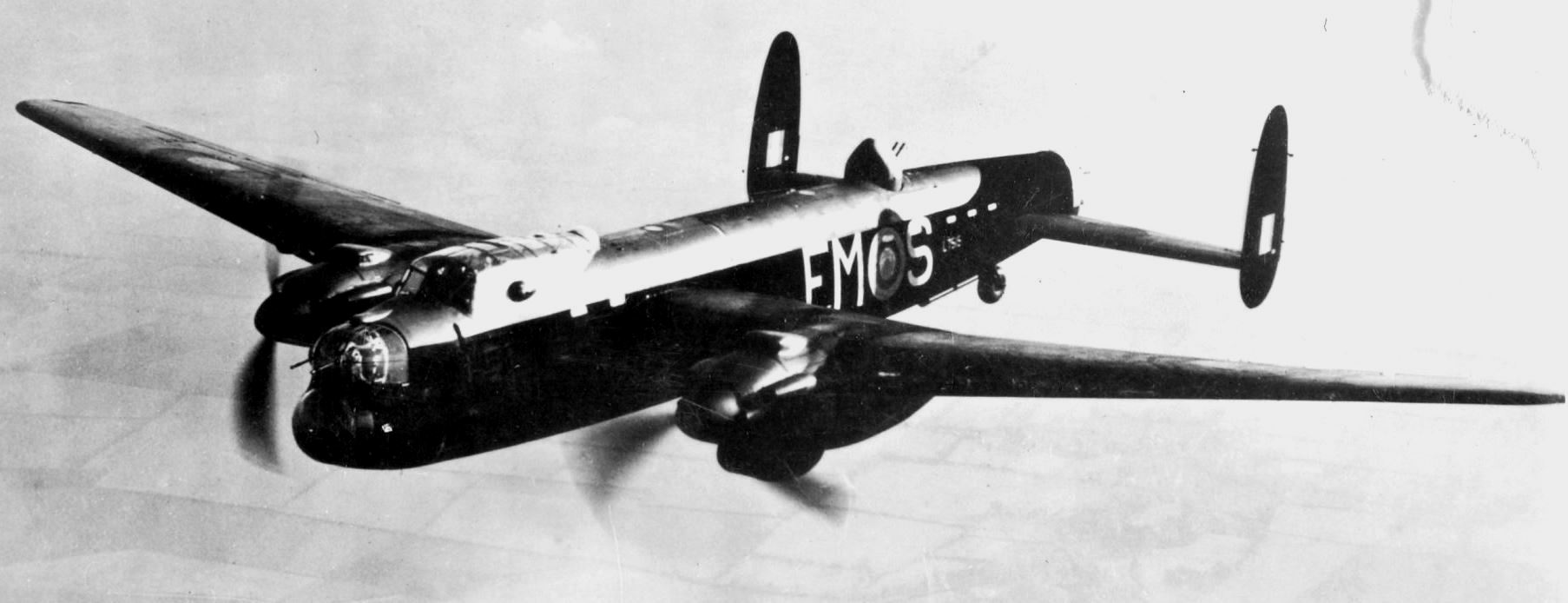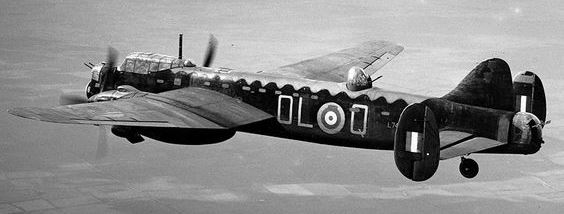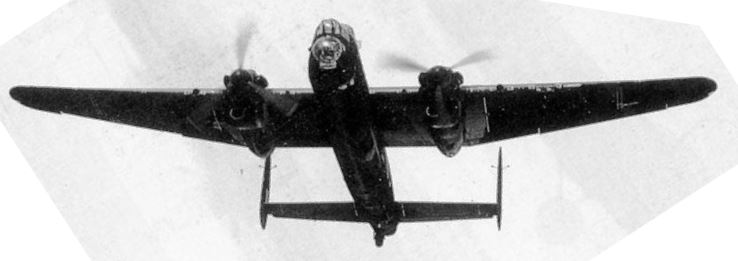Canadian Warplanes 3: Avro Manchester
Avro Manchester
The Avro 679 Manchester was a British twin-engine medium bomber developed and manufactured in the United Kingdom. While not being built in great numbers, it was the forerunner of the famed and vastly more successful four-engined Avro Lancaster. Avro designed the Manchester to replace its inventory of twin-engine bombers. It first flew on 25 July 1939, and entered squadron service in November 1940, just over twelve months after the outbreak of the war. Operated by both RAF and the RCAF, the Manchester proved to be underpowered and unreliable, and production was terminated in 1941. However, the Manchester was redesigned into a four-engined heavy bomber, the Avro Lancaster, powered by Rolls-Royce Merlin engines. (Wikipedia)

(RCAF Photo)
Avro Manchester Mk. IA, (Serial No. L7284), coded D-EM, powered by a pair of Rolls-Royce Vulture engines. None were on the RCAF establishment, but many were flown by RCAF aircrews serving with the RAF overseas in No. 408 and No. 420 Squadrons during the Second World War.
During May-June 1942, No. 408 Squadron, RCAF, had one Manchester aircraft, (Serial No. L7401), coded EQ1N, for evaluation as a possible replacement for the Handley Page Hampden. A Manchester Conversion Flight was set up under S/L L.B.B. Brice, who flew this aircraft on its two sorties with the squadron: the 1,000-plane raid on Cologne, 30/31 May, and a bombing of Essen on 1/2 June 1942. The Manchester had to turn back from Cologne owing to hydraulic failure; in the raid on Essen it dropped 126 four-pound incendiaries. The last Bomber Command sorties by Hampden aircraft were flown by No 408 Squadron on the night of 14/15 September 1942 against Wilhelmshaven, Germany.
No. 408 (Goose) Squadron operated the following Manchester B. Mk. I's:
(Serial No. L7400).
(Serial No. L7401), coded EQ-X and Bar later changed to EQ-N and Bar.
(Serial No. L7415), coded EQ-B and Bar.
(Serial No. L7419).
(Serial No. L7425), coded EQ-C and Bar.
(Serial No. L7428).
(Serial No. L7484), coded EQ-? and Bar.
(SerialNo. L7727).
(Serial No. R5835), coded EQ-N and Bar.
The Manchester Conversion Flight operated (Serial No. L7401) and (Serial No. R5775).
No. 420 (Snowy Owl) Squadron, RCAF, flew the following Avro Manchester B Mk. Is in Dec 1941:
(Serial No. L7291).
Serial No. L7386).
(Serial No. L7400).
(Serial No. L7402).
(Serial No. L7416).
(Serial No. L7496)
(Serial No. R5771). The Squadron's Manchester Conversion Flight also used the same aircraft. (Chris Charland)

(SDASM Archive Photo)
Avro Manchester Mk. I, coded EM-S.

(RAF Photo)
Avro Manchester Mk. I, coded OL-Q.
One of a series of shots taken of an Avro Manchester Mk1 twin-engine heavy bomber, L7427, OL- Q of No.83 Squadron flying on 21st April 1942, near Scampton. The nose of the aircraft (just out of shot on the angle) showed mission symbols indicating that it had completed 10 operational sorties at the time the photo was taken. It went on to complete four more missions before it was lost on its 15th mission, during a raid on the Blohm und Voss shipyards in Hamburg. No. 83 Squadron was the first to use the powerful “Cookie” bomb, weighing 4,000 pounds (1814 kilograms), in an operational capacity.

(RAF Photo)
Avro Manchester Mk. I, coded OL-Q.
Manchester's were to continue in service with the RAF until 24 June 1942, when the last squadron was re-equipped with the Handley Page Halifax. The Manchesters were then relegated to training purposes, where they remained for a short period. They were completely removed from the RAF's requirements before the war's end.
200 airframes completed as true Manchesters were issued to front line RAF squadron's,. Of these, a total 77 aircraft were lost on operations and an additional 20 were lost in various accidents with those squadrons. An additional 24 aircraft were lost during training flights with non-operational units, such as those being used by Heavy Conversion Unit (HCU) Flights. Combined losses therefore, were 121 or 60.50 percent of the original 200 aircraft. From those losses, 33 were directly due to engine failures - 12 with the squadrons, 21 with training units. Another 28 aircraft lost during operations, were thought to have been caused due to engine failure. As the airframes and engines could not be examined, these are listed as "Probably Lost Due To Enemy Action".

(RAF Photo)
Avro Manchester Mk. I (Serial No. L7427), coded OL-Q, No. 83 Squadron, 1941

(IWM Photo, CH 3879)
The forward section of an Avro Manchester Mk. I of No. 207 Squadron, RAF, while running up the port Rolls-Royce Vulture II engine at Waddington, Lincolnshire, 12 Sep 1941. This view shows the nose with the bomb-aimer's window, the forward gun-turret and the pilot's cockpit.
193 operational Avro Manchesters flew 1,269 sorties with Bomber Command, dropping 1,826 tons of bombs. 78 Manchesters were lost in action, with aircrews flying the last Manchester operation against Bremen on 25 June 1942. A further 45 were non-operational losses of which 30 involved engine failure. The Manchester was withdrawn from operations in mid-1942 in favour of more capable aircraft. Its final role in RAF service was as instructional trainers for converting crews to the RAF's new Lancaster bombers. The Manchester and Lancaster shared nearly identical crew positions and fuselages. The type continued to be used for training purposes into 1943 before being completely retired.

(RAF Photo)
Avro Manchester Mk. I.

(RAF Photo)
Avro Manchester Mk. IA.

(RAF Photo)
Avro Manchester Mk. IA.

(RAF Photo)
Avro Manchester Mk. IA.

(RAF Photo)
Avro Manchester Mk. IA, coded EM-S.

(RCAF Photo)
Avro Manchester Mk.1A (Serial No. L7486), with extended tail fins.

(RCAF Photo)
Avro Manchester Mk.1A (Serial No. L7486), with extended tail fins.

(RAF Photo)
Avro Manchester Mk. I (Serial No. L7427), coded OL-Q of No. 83 Squadron, RAF.

(RAF Photo)
Avro Manchester Mk. I (Serial No. L7279), coded --EM, No. 207 Squadron, RAF.

(IWM Photo, CH 3884)
Inside an Avro Manchester Mk. I (Serial No. L7288), coded EM-H, No. 207 Squadron, RAF, at Waddington, Lincolnshire, looking aft towards the rear turret with a member of the crew posing by the flare chute, c1941.

(IWM CH 3880)
Interior view of the cockpit of an Avro Manchester Mk. I (Serial No. L7288), coded EM-H, of No. 207 Squadron RAF at Waddington, Lincolnshire, showing the captain, Flying Officer P Burton-Giles seated at the controls, and the bomb aimer leaving his seat in the nose section.

(RAF Photo)
Nash and Thompson FN4A tail turret of an Avro Manchester Mk. I of No. 207 Squadron, RAF.





